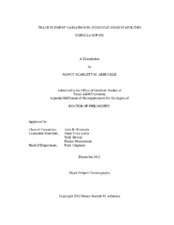| dc.description.abstract | Range expansion events of the Humboldt squid reveal our inadequate understanding of populations of this species. Despite recent hatching, reproductive, tagging, genetic and dietary studies of Dosidicus gigas, much speculation remains concerning geographic migration, stock assessment and habitat preferences. This study provides evidence that statolith trace elemental variations can be useful in distinguishing among geographic populations. Specimens were collected from the Galapagos Islands, southern California, and Washington State. A dissection method was recorded and published. By using laser ablation methods, discrete measurements of 10 elements were collected at 6 to 7 ablation sites covering embryonic, paralarval, juvenile and adult stages. Analysis of Variance revealed important ontogenic elemental variations among ablation locations. Multivariate Analysis of Variance, ordination techniques and discriminant function analysis with permutation testing were all utilized to compare and characterize the variations found in elemental concentrations. Significant ontogenic variations were found for 8 out of the 10 focus elements; this is the first report for 5 of these elements for this species. The geographic populations were effectively classified as distinct group for the first time using these methods. Elemental fingerprint signatures were found to be significantly different at multiple ontogenic growth regions of the statolith. Seattle and California paralarvae exhibited similar elemental signatures despite significant differences in those found in the embryonic core and juvenile regions of the statolith. These methods are a useful tool in providing stock assessment and can be improved for use in future population dynamics models. | en |


